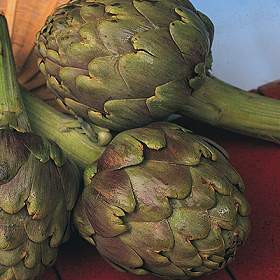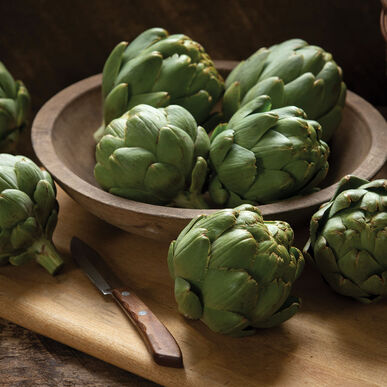Artichoke Seeds
Useful gardening information
The large flower buds are harvested just before they begin to open. These heads usually start to develop a reddish color when they are ready to be cut. Artichokes can be eaten raw, but are usually steamed for a half hour to 45 minutes, depending on size. The petals or "scales" will pull off easily when they have cooked enough. In addition to the artichoke heart (the base of the flower) the thickened flesh at the base of the larger scales may be scraped off and eaten. The scales get smaller and smaller the deeper you get into the center of the head. The small undeveloped petals are scraped off, leaving the heart.
Most varieties, such as Green Globe Improved, will not produce a crop the first season, and so must be wintered over. The plants will tolerate frozen soil if covered by a thick layer of mulch. Mice may be a problem, tunneling through the mulch to consume the plants during the winter. Overwintering this tender perennial is easier in areas with a mild winter. The flower buds are usually produced in late spring or early summer the second year.
Sowing Instructions
Sowing Outdoors
Direct sow in early spring when soil temperatures reach
55°F. Direct sown plants may not mature the first year in
zones 6 and below. Fertilization Tips-Apply 1 cup of a blended
organic fertilizer or a shovel full of chicken manure around
each transplant to provide the nutrition necessary for optimum
production.
Informative articles found on the web:
20 great artichoke recipes
All about artichokes
Artichokes 101
How to grow artichokes


Harvest when immature for pickling or allow to grow to their usual 4" diameter.
Another benefit of Tavor is its improved cold tolerance over the Winter months when the crowns of other varieties can be killed off by prolonged hard frost.
An improved Imperial Star-type for low-input systems that features minimal spines for easier harvesting. The 2–3' plants have an open habit and produce an average of 1–2 primary buds per plant averaging about 3–4" in diameter. Secondary buds average 5–7 per plant at 1 1/2–2" in diameter. Perennial in Zone 7 and warmer; otherwise treat as an annual.

